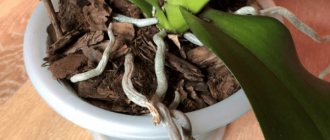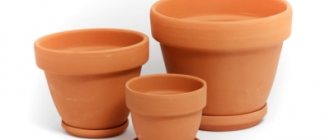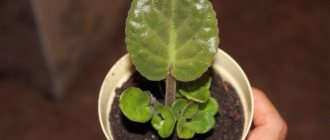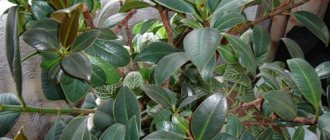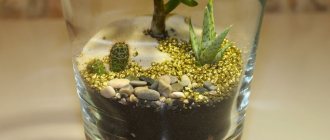When creating home collections of violets, flower growers at a certain stage come to the need to supplement their collection with trailer varieties .
Such varieties, distinguished by their spectacular rosette contours and multiplicity of flowering, are able to add a fresh flavor to any varietal selection and delight with their flowering for quite a long time. Caring for trailer forms will not add problems to collectors, since it differs only in the need to form the outlines of plants.
Main features of cultivation
Differing in the shape of the bush and long flowering, trailers of Saintpaulia have slightly different requirements for the processes of their formation and maintenance than ordinary violets. Some care methods differ in minor nuances.
But there are also specific features - planting methods and bush formation , which is mandatory for many varieties of trailer violets.
Planting methods
You can plant the only child of the plant in the center of the flowerpot , pinch off the growing point, and then form a violet trailer with the required number of flower centers, removing excess stepsons and leaves. This planting is good for plant varieties that produce abundant shoots .
It is advisable to plant varieties of the bush group in one flowerpot, several at a time, preferably in a circle near the edges. And be sure to control the initial size of the children - it must match. The plant's children will give rise to stepchildren and form a smooth clearing.
When planting a leaf with children, a ready-made trailer violet bush will gradually form in the center of the flowerpot.
Features of growth and development
The main distinguishing feature of the processes of contour formation and growth of the trailer violet is its ability to form numerous shoots in the leaf axils, as well as grow elongated stems.
A large number of axillary children, mercilessly removed from ordinary varieties of violets, allows the trailer forms to create their own unique contour of the bush group. Each child has its own growth point, which means it produces strong, slightly elongated stems that grow straight upward. All stems together provide a convex volume.
Stepchildren are not removed from trailers.
The formation of violet trailers of the ampelous group occurs according to a slightly different scenario. They are able to form cascading plant contours due to the growth of elongated stems with axillary children. In this group, the shoots fall down in the form of lashes or are distributed over the surface of the substrate.
The more additional shoots are formed, the more abundant and longer the flowering will be.
Basic care
Comfortable growth of trailer violets requires careful adherence to all basic regimes for keeping plants indoors:
- providing long-term diffuse spectrum lighting and backlighting in winter;
- maintaining the temperature at +20 + 24°C with minor daily differences;
- protection of violet trailers from drafts and sudden temperature fluctuations;
- maintaining proper and regular watering of the plant, avoiding overwatering or drying out of the soil;
- applying fertilizers for adult trailer violets at a time determined by visual monitoring of the plant;
- replanting the plant using the transshipment method as the trailer violet grows out of the pot.
Formation of a flower bush
Many varieties of trailer violets require the formation of a bush outline, otherwise they can grow into a shaggy and awkward plant. There are several ways to create a beautiful specimen , and each gardener chooses the one that suits him:
- You can get the right trailer violet bush from a single child with about 10 leaves . The growth point of such a plant is pinched, due to this the axillary shoots begin to grow. After they are sufficiently decorated, the lower leaves of the plant are removed, and at the same time, damaged or non-standard leaf plates are cleaned. For a beautiful volume of the trailer violet bush, only a few of all the axillary children are left (ideally 5);
Children of the trailer violet.
- when planting several plant children in a circle in one pot, they eventually form a clearing, which requires formation by removing excess leaves and directing shoots to empty spaces;
- It is ideal to form ampelous varieties of trailer violets in a flowerpot on a high leg or in a hanging pot . In this case, part of the plant’s stems are directed downwards, and the remaining stems growing next to them are pinched to create volume in the flowerpot itself;
- Another way of forming ampelous varieties of trailer violets involves laying out the stems of the plant on the substrate - gradually, with the help of new children, an even carpet will be obtained.
ATTENTION! For all methods of forming the outline of a violet trailer, it is necessary to thin out the leaves, control the uniform elongation of the main stems of the plant, and fill the bare areas with newly formed shoots. When these rules are followed, trailer violets turn out to be even, symmetrical plants with evenly filled space with leaf blades and buds.
Photo catalog of common varieties
Of the variety of varieties of trailer violets, some are especially popular. Below we will present photos and names of the most common trailers used in home growing.
Edee s Rosebud – “Rose Bud”
A miniature trailer with a pronounced but sometimes disappearing variegation : the leaf plates are painted in a light green color with a golden tint.
Forms numerous buds of a pastel, peach hue, opening with terry corollas with dense filling. The contour forms independently and is characterized by rapid growth.
Edee's Rosebud.
The variety belongs to the hanging method of cultivation . Can grow to a semi-miniature group.
Lituanica
An old selection variety that was not previously considered a trailer violet . But for its ability to actively form axillary children, it is currently included in the semi-miniature group of trailers.
It has leaf blades with pointed edges, painted dark green. It blooms for a long time with a large number of pink corollas with iridescent colors, but on the condition that all stepsons are removed from the plant. The flowers are double, full, and resemble dahlias.
Lituanica.
Violet belongs to the bush growing method . The variety does not like interference from gardeners.
Rob's Vanilla
Semi-miniature trailer , in some cases not wanting to form axillary children in sufficient quantities. Not always ready to form a compact bush from it, likes to form an outline on its own.
Provided that the flower shoots are pinched and cut off in the early stages of growth, the plant can develop into a harmonious bush with a strong stem and not too elongated stems.
The variety produces a mass of double roses in white, pinkish and cream shades.
Rob's Vanilla.
Trailer for the hanging method of growing . Prefers to grow in a group of several specimens in one flowerpot.
Dancin
trailer . It is distinguished by its dark green leaf blades, colored underneath with a reddish tint.
The variety produces slightly double corollas of red-raspberry color.
Dancin.
Trailer violet is a bush growing method. The variety has a significant drawback - it is very slow : it grows for a long time, thoughtfully forms buds and does not bloom many of them.
Rondita
A variety from the semi-miniature trailer group . A distinctive feature of the plant is the almost complete absence of the pinching process . It is best to create a decorative outline by planting several specimens in one flowerpot. The variety is too moisture-loving.
The leaf blades of the trailer violet are round in shape, colored in a deep shade of green. Forms a large number of terry corollas with dense filling. The color of the flowers is pink with a bright tint.
Rondita.
Trailer violet belongs to the hanging method of cultivation . The peculiarity of the variety is that it is not afraid of direct rays of the sun.
Ramblin silver
Semi-miniature trailer , representative of a group of varieties with variegated foliage. The leaf blades are painted in a light green color with yellowish streaks.
The variety produces white, semi-double corollas. Often sports, forming pink flowers.
Ramblin silver.
Trailer violet is a bush growing method.
Some of my trailers are blooming
Rob's Boolaroo, lives on the window, bloomed until December inclusive, took a break in January, picked up buds again in February and is now like this.
The trailer sounds like a song.
Well I really like them
Double creamy pink ball flowers with green petal tips; dark green smooth pointed foliage. Mini trailer
At the exhibition at the Violet House in Moscow, as a bonus, I was given a cutting of a Rob's Humpty Doo violet. I looked it up on the Internet when I got home and found out that it was a miniature chimera trailer. What was the point of giving a cutting of a chimera if the plant is not bred that way? Or is it different with trailers? Still, she rooted him and now he has a lot of children. Maybe they should be planted in bunches?
Features of care
Saintpaulias of trailer forms, in terms of the conditions for keeping them indoors, are not much different from ordinary varieties of violets: they are not too demanding in the process of care, they only sometimes show their character, they do not like transplants, but they definitely need to form a decorative outline.
You just need to study their life attitudes and follow the advice of experienced flower growers to get decorative bushes.
Content Rules
The main conditions for the comfortable growth of any plant are:
- correct placement of the specimen in the room;
- creating the necessary light regime;
- maintaining temperature indicators at the required level.
In terms of lighting, violet trailers have some requirements. Due to the constant formation of buds, they need long daylight hours (ideally half the day) without prolonged exposure to direct rays of the sun.
These conditions can be met by placing the pots on the windowsills on the east or west side and creating additional lighting with fluorescent spectrum lamps in cold seasons.
Flowering for a long time in trailer forms of violets is impossible without slight differences in temperature at different times of the day and night.
The optimal temperature characteristics for them will be +20 + 24°C during the day and about two degrees less at night. It should be noted that the age of the trailer violet affects its temperature preferences: young specimens are more demanding of heat than adult plants.
CAREFULLY! All varieties of trailer Saintpaulias cultivated at home are especially afraid of drafts and sudden temperature changes. Therefore, ventilation of premises should be carried out under close monitoring of air flow movements in dangerous proximity to violets. And under no circumstances should they be allowed to be exposed to direct blows.
Watering requirements
Compliance with the irrigation regime involves regular watering without overflowing or drying out the soil at any time of the year. The amount and frequency of watering depends on the room temperature, air dryness, the size of the flowerpot and the trailer plant itself. It is optimal to water once every 7 days , but for mini and microminiature groups - a little more often due to their small size.
Microminiature varieties are watered more often than standard varieties.
For a trailer violet, it is necessary to create a good drainage system in the vessel. also drain excess water from the pan to prevent rotting of the roots.
Top dressing
Trailer varieties of violets are in a blooming state for most of the year, so for sufficient nutrition they need regular, but not frequent feeding.
Fertilizers should be applied once a month after preliminary watering of the plant . The dose indicated on the package should be reduced several times. It is possible to alternate feeding with organic and mineral fertilizers.
It is forbidden to feed recently planted or transplanted specimens (the standby period is about 2 months) - there is a danger of chemical burns to the plant from an overdose of fertilizer.
It is not recommended to feed young plants until they are two years old.
Transfer
fast-growing young specimens twice a year , provided they grow out of an old flowerpot. With each subsequent transplant, the pot is taken to be slightly larger in diameter, but its depth does not need to be increased.
As the violet-trailer grows up, it begins to have an increasingly negative attitude towards interference in its life rhythms. Therefore, transplants are reduced to once every 3 years , carried out using the transshipment method. Gradually you can move on to partial replacement of the top layer of the substrate.
Adult trailer violets do not like frequent transplants.
ADVICE! To enhance the decorative effect that trailers of hanging violets have, you should choose flowerpots with high stems or hanging vessels. This will make it more convenient for the plant to form its contour.
After transshipment and slight compaction of the substrate, you need to remove old, damaged and non-standard leaves to allow the trailer violet to quickly grow more children and form a lush green mass.
How to grow miniature violets: mini, semi-mini, micro-mini and trailers
Half-mini and mini violets are very beautiful indoor plants that have completely retained the exquisite appearance of regular Saintpaulia, but have acquired a special miniature size. The difference between such violets and ordinary ones lies, first of all, in their small, sophisticated size. Depending on the variety, plants vary in the color of flowers and leaves, size and cultivation characteristics.
Features of mini, macromini and semi-mini violets
There are several varieties of miniature Saintpaulias, which differ from each other in the diameter of the leaf rosette: • semi-mini - one of the largest rosettes in miniatures, which can grow up to twenty centimeters; • mini - the average diameter of the socket is fifteen centimeters; • micromini - the rosette of the plant can be no more than six centimeters. Plants with rosettes no larger than fifteen centimeters are considered real miniatures. The rarest miniature Saintpaulias are microminis. Microminiature violets are quite demanding to care for, require a special approach to cultivation and are most often kept in greenhouse conditions. However, it is possible to grow micromini violets at home. You just need to stick to the basics of caring for this fragile flower.
It is also worth highlighting a special group of miniature violets, namely trailers. They are often called ampelous violets, however, this is a misnomer. In fact, trailers are a special type of creeping violets with many stepsons and a fairly long stem. Trailer violets can grow either vertically or spread out in the form of a bush. Trailer-mounted violets are grown in a similar way to real trailer-mounted violets. Also, trailers can be planted, like groundcovers, in flowerpots, carefully forming flowering lawns by pinching. Trailer violets also vary in size: they can be lush and large bushes or tiny miniature plants. The shape and size of trailers depend on the characteristics of agricultural technology and, of course, the variety.
Caring for miniature violets
Caring for miniature violets is quite easy, but the condition and development of the flower depends on proper care. If you decide to have these beautiful plants on your windowsill, you should provide them with proper care. Miniatures require more care than standard Saintpaulias, but the approach to these plants is similar. It is worth noting that miniature Saintpaulias are much hardier than standard ones. With regular and high-quality care, they bloom actively and profusely, delighting with lush rosettes and large flowers. Mini, trailer, semi-mini and micro-mini violets require special maintenance: proper lighting, watering, high-quality soil and special pots for planting and replanting.
Watering
For Saintpaulia miniatures, watering is one of the most important components of care. Due to the fact that plants are grown in small pots, the soil often dries out. During the hot season and in warm climates, daily watering may be required. Miniature violets are watered in different ways: from above, from below, using a wick. It is most preferable to water mini violets using a wick or from above. If you decide to water your miniatures using a wick, you should install it when planting or replanting the plant. If there is no wick, you can water the violets from above using a syringe without a needle or a small medical bulb. The earthen ball should be completely moistened when watering, however, under no circumstances should moisture get on the plant’s rosette. If water gets on the rosette of miniature violets, the plant may rot.
As a rule, violets are watered in the morning of the year in summer and spring; in winter and autumn, watering can be done in the daytime. There must be drainage at the bottom of the Saintpaulia pot so that the roots of the plant do not rot and the soil does not retain moisture. Water for watering Saintpaulias should be filtered and settled. Before watering, the water must stand in an open container for at least a day. When watering mini, micromini and semi-mini violets, you can add fertilizers - granular or liquid. Violets need to be fertilized twice a month with special compounds for Saintpaulias.
READ ALSO: How to grow the most popular plant from Instagram? All about growing a gorgeous tropical flower - monstera
If there is a lack of sufficient moisture, the roots of Saintpaulia and the earthen ball dry out. The soil easily peels off the walls of the container in which the violet is planted. In this case, when watering, water will flow down near the walls and the plant will continuously dry out until it completely withers. To “water” such a violet, you should take out the earthen lump and immerse it a little in a tray with moisture for five minutes.
Temperature and humidity
When caring for Saintpaulia miniatures, you should not forget about the optimal air temperature in the room. For normal growth, the plant requires a temperature regime of twenty degrees Celsius, but no more than twenty-five. The preferred air humidity should be between 50-70%. In order to provide violets with the necessary humidity during the heating season, miniatures should be placed on pallets with moistened sand or expanded clay. You can also place a small open container of water next to mini, semi-mini and micromini Saintpaulias to increase air humidity.
Lighting
In order for miniature Saintpaulias to form nice lush rosettes and bloom quickly and profusely, the plants should be provided with proper lighting. You should base your lighting needs on the sockets - the smaller the socket, the more sunlight the violet needs. The brightness of the lighting can be adjusted by moving or moving the Saintpaulia pots closer or further from the window frame. It is better to place micromini and mini closer to the glass, and semi-mini - a little further. This way the plants will receive enough sunlight and will not be shaded by larger plants. However, this is only relevant in winter. In hot summers, violets should be hidden from direct sunlight.
If Saintpaulia miniatures are grown under artificial light, half minis should be placed thirty centimeters from the lamp, and half minis and microminis should be placed at a distance of fifteen centimeters. If you want to achieve lush and active flowering, you should place the plants at a distance of ten centimeters from the artificial light source. There is no need to place Saintpaulia at a closer distance, as the plant will overheat from the heat generated by the lamp.
The duration of the classic daylight hours under artificial lighting depends on the task facing the grower. If you want to achieve quick and lush flowering, the lighting timer should be set to twelve hours of continuous lamp operation. To ensure good and healthy growth of plants, a daylight period of ten hours should be provided. It is important to remember that excess light for miniature violets is no less harmful than its lack. If there is excessive light, the leaves of the Saintpaulia close together, new flower stalks rarely appear, the rosette becomes flat, and the violet foliage may turn yellow. With a lack of lighting, the flower becomes paler, smaller and grows extremely slowly.
Priming
Since the containers for planting trailers, mini, semi-mini and micro-mini violets are very small, the soil in the gooshocks quickly cakes, the acidity of the soil changes, and micronutrients are quickly washed out. In order for the plant to develop well and bloom profusely, miniature Saintpaulias are replanted twice a year, changing both the pot and the soil mixture.
READ ALSO: Chrysanthemums: planting, care and propagation
Microcultivars do not need soil loosening agents. The ideal soil for them is a mixture of top cake, sand and drainage from sphagnum, expanded clay or perlite.
The optimal soil mixture for Saintpaulia miniatures consists of: • vermiculite - 15%; • crushed charcoal - 3%; • nutrient soil - 42%; • perlite – 10%; • high-moor peat – 15%; • sphagnum - 15%.
Feeding
When Saintpaulias are regularly transplanted into new soil, the plants practically do not need fertilizing. It is necessary to fertilize the violet at those moments when the plant really needs it: with insufficient growth, rare flowering. As a top dressing, you can use organic or mineral mixtures for Saintpaulias. However, the concentration of the solution for mini, micromini and half-mini should be half that for standard violets.
For Saintpaulias, you can select complex fertilizers based on potassium, phosphorus or nitrogen.
Propagation of mini, micromini and semi-mini violets
Miniature violets are usually propagated by cuttings. To choose the right cuttings, you should pay attention to healthy leaves without any damage or yellowness. The leaf should be juicy and completely green. Other types of leaves die quickly and do not take root or produce very weak offspring. The selected leaf must be carefully separated with a sterile knife and placed in a solution of a fungicidal drug to prevent the development of fungal infections on the cutting.
After soaking in the fungicide, the cutting is washed in lukewarm water and a new cut is made using a sterile knife. Just a centimeter of cuttings is enough for engraftment. The cut on the sheet must be clean and even, the tool for this must be sharp enough and, of course. treated with alcohol. The place of the new cut is treated with charcoal for disinfection.
Leaves of miniature Saintpaulias are immediately planted in the soil mixture. There is no need to keep the cuttings in a glass of water before planting. Thus, the leaf can rot, and its survival rate is significantly reduced. The soil for planting cuttings must be of high quality and breathable.
The leaf is planted in the ground at an angle of forty-five degrees. The leaf is carefully sprinkled with the prepared soil mixture and after planting it is lightly watered with settled warm water. The depth of the hole for planting the cutting is no more than one centimeter.
A couple of weeks after planting the cuttings, the plant will take root and the first leaves will appear on the surface of the soil. After the first three pairs of leaves appear, Saintpaulia can be planted in normal pots with new soil. If the main sheet has withered or deteriorated during this time, it must be cut off and the fresh cut treated with charcoal. Sprinkle the plant in the pot with plenty of soil so that the roots develop better. You should also avoid early flowering of violets grown from cuttings. If Saintpaulia sends out flower stalks in the early stages of development, they need to be removed in order to preserve the violet's strength to grow.
Miniature violets have many advantages and differ from standard Saintpaulias in that they are compact, have small and neat rosettes, and take up little space on the windowsill. Mini, micromini and semi-mini violets bloom profusely and very luxuriantly. Sometimes even the leaves are not visible behind the flowering. Caring for miniature violets is much simpler and easier. Such plants get sick less often, grow quickly, bloom much earlier than Saintpaulia standards, and separated petioles take root and develop much faster.
Reproduction
Trailer violets are capable of forming young specimens in two ways:
- rooting the selected shoot without separating it from the mother plant;
- the formation of children on the rooted leaf plate.
The main condition for the rapid formation of roots and painless separation of overgrown cuttings is the use of a special substrate.
It can be prepared from ordinary soil with the addition of a significant amount of loosening agent (perlite), but you can also replace the soil with sphagnum.
Provided additional illumination, the root system in children or cuttings is formed quite quickly (about 15 days). After planting new specimens in their own flowerpots, they should set up a kind of greenhouse for several days. Further care is carried out according to the standard scheme.

